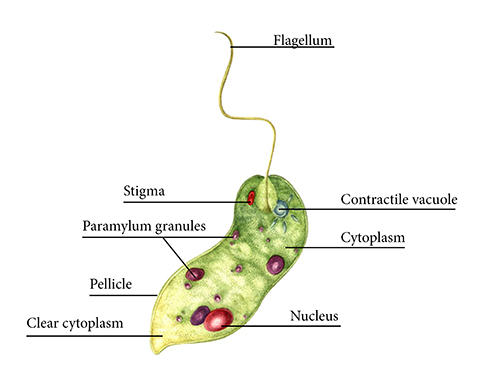Marvellous micro-organisms 3: Euglena

This final blog on micro-organisms, features the Euglena. Like the Ameoba and Paramecium, the euglena is a free-living unicellular organism.
Introduction to the Euglena
It is found in fresh water (often in puddles or ponds) and differs from ameoba and paramecium in being able to photosynthesize, and so produce its own source of food. The euglena appears green due to the chloroplasts in its cytoplasm, sites where photosynthesis occurs. In reality, these can often appear clearer and larger than in my diagram, like green rods.
The euglena can also surround and take on food through phagocytosis (see my blog on ameoba) so is not entirely autotrophic (producing its own food).
Movement in Euglena
Euglena moves by thrashing its whip-like tail or flagellum. In fact, it has two flagella, one far smaller (not shown). These produce a spiral, helicoidal motion which casues the euglena to spin along as it moves forward. To see euglena moving, and how bright green they are, have a look at Craig Smith’s euglena video.
The eye of the Euglena
The stigma is a visibly red eye-spot, its colour coming from caratenoid pigmentation. This little spot will cover up a photo-receptive area (the paraflagellar body) at the base of the flagella periodically, causing the euglena to change position until the photoreceptor is exposed again. This cunning process means the euglena can sense where light is, and move towards it. Obviously, in an organism that requires sunlight to photosynthesize and thus feed itself, moving towards light is paramount.
As with amoeba and paramecium, the unicellular euglena needs to regulate water levels within its body. It uses a contractile vacuole for this, which expells excess water and thus ensures osmoregulation. As with paramecium, there are radiating canals, functioning like drainage paths, leading to the vacuole. Without a contractile vacuole; euglena, ameoba, and paramecium would absorb too much water through osmosis and would explode.
Euglena store carbohydrates in their bodies in the form of paramylon or paramylum granules, similar to starch. These reserves vary in size and act as food reserves.
Their nucleus controls all the life functions; feeding, growth, regulation, digestion and (within the nucleolus inside the nucleus) reproduction. Euglena can only reproduce asexualy, through binary fission, The nucleus divides mitotically and then the cytoplasm will split longditudinally.
I’m no expert on micro-organisms, and in fact when I was at University they were all still bundled together into the now obsolete phylum of “protozoa”. Please do let me know if there are any mistakes that need fixing, and I’d be delighted to fix them.

